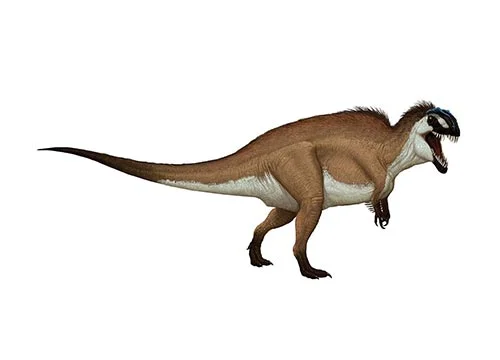Acrocanthosaurus (High spined lizard)

Acrocanthosaurus, also known as “High spined lizard”, was named by paleontologist John Willis Stovall & Wann Langston, Jr. in 1950. This carnivorous dinosaur lived during the Early Cretaceous, approximately 115-105 million years ago. Acrocanthosaurus was a Large Theropod, estimated up to 11.5 meters in length. Acrocanthosaurus fossil remains were found in USA, Oklahoma, Antlers Formation, and the Texas, Twin Mountains Formation. Some specimens from other parts of the US, shedding light on the ancient ecosystems of this region and it is offering valuable insights into the prehistoric world and the evolution of Large Theropod dinosaurs.
Ak-row-can-fo-sore-us
John Willis Stovall & Wann Langston, Jr. - 1950
USA, Oklahoma, Antlers Formation, and the Texas, Twin Mountains Formation. Some specimens from other parts of the US
Early Cretaceous, 115-105 million years ago
Acrocanthosaurus Facts
In the grand gallery of Earth’s ancient rulers, some dinosaurs stand out for their imposing stature and fearsome presence. Among these colossal carnivores is Acrocanthosaurus, a true titan of the Early Cretaceous period. Named by paleontologists John Willis Stovall and Wann Langston, Jr. in 1950, Acrocanthosaurus is often likened to an “High spined lizard” of its time, possessing remarkable adaptations and size that set it apart in the world of dinosaurs.
Acrocanthosaurus, a carnivorous dinosaur, prowled the Earth approximately 115-105 million years ago, during the Early Cretaceous. This was a time when colossal predators ruled the landscape, and Acrocanthosaurus was undoubtedly one of the most imposing.
Estimated to reach lengths of up to 11.5 meters, Acrocanthosaurus was a true giant among theropods. Its most distinctive feature was the row of tall neural spines that ran along its back, giving it the appearance of having “high spines.” These spines were likely covered in muscle and may have supported a sail-like structure, although their exact function remains a subject of study and debate. Its powerful jaws, filled with sharp teeth, were unmistakably designed for hunting and tearing into prey.
Fossil remains of Acrocanthosaurus have been discovered in various parts of the United States. These finds include locations in Oklahoma, specifically the Antlers Formation, and Texas, within the Twin Mountains Formation. The presence of Acrocanthosaurus in different regions offers valuable insights into the diversity of ecosystems during the Early Cretaceous and the wide distribution of this remarkable predator.
As a carnivore, Acrocanthosaurus likely dominated the food chain of its time, preying on a variety of animals, including other dinosaurs. Its unique adaptations, such as its formidable jaws and potential sail-like structure, reveal a glimpse into its predatory strategies.
Acrocanthosaurus is a key figure in the study of theropod evolution during the Early Cretaceous. Its distinctive features and ecological role provide valuable data for understanding how these apex predators adapted and diversified over millions of years.
Acrocanthosaurus, the mighty ruler of Early Cretaceous realms, may not be as well-known as some of its dinosaur contemporaries, but its legacy is etched in the fossil record of North America. This large theropod dinosaur offers a fascinating window into the ancient ecosystems of the Early Cretaceous and the evolutionary journey of formidable carnivorous dinosaurs.
As paleontologists continue to unearth more about Acrocanthosaurus and its prehistoric world, our appreciation for the intricacies of Earth’s history deepens. Each discovery brings us closer to comprehending the awe-inspiring giants that once roamed our planet, reminding us of the incredible diversity of life that has thrived throughout Earth’s long and dynamic history.



